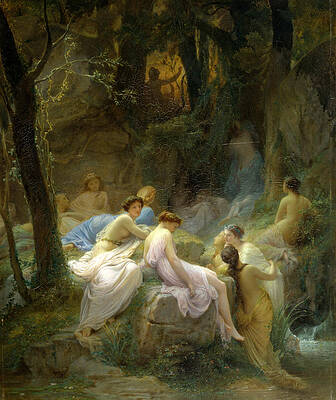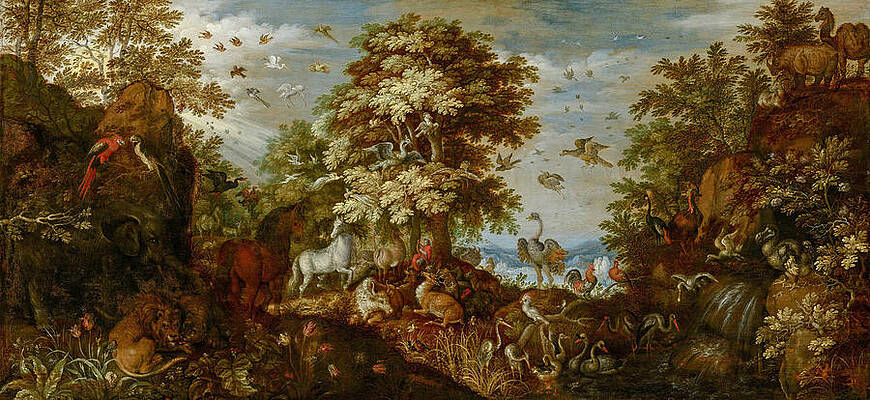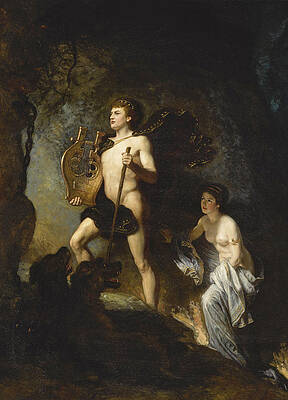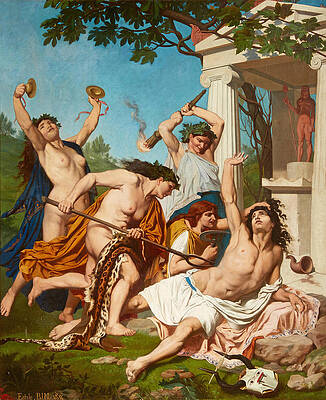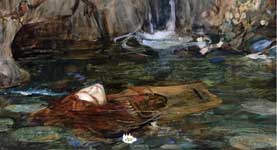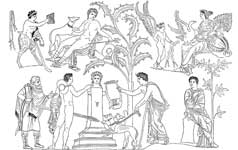.
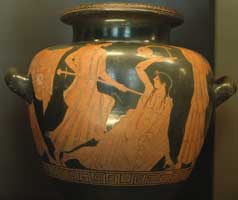
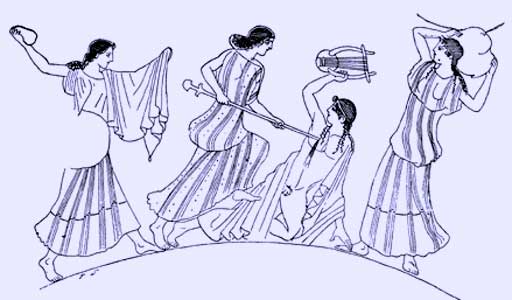
In Greek legend, Orpheus (Ορφέας) was the chief representative of the arts of song and the lyre, and of great importance in the religious history of Greece. The mythical figure of Orpheus was borrowed by the Greeks from their Thracian neighbours; the Thracian "Orphic Mysteries", rituals of unknown content, were named after him.
Overview
The name Orpheus does not occur in Homer or Hesiod, but he was known in the time of Ibycus (c. 530 BC), and Pindar (522—-442 BC) speaks of him as “the father of songs”.
From the 6th century BC onwards he was looked upon as one of the chief poets and musicians of antiquity, the inventor or perfecter of the lyre, who by his music and singing was able not only to charm the wild beasts, but even to draw the trees and rocks from their places, and to arrest the rivers in their course. As one of the pioneers of civilization, he was supposed to have taught mankind the arts of medicine, writing and agriculture. As closely connected with religious life, he was an augur and seer; practised magical arts, especially astrology; founded or rendered accessible many important cults, such as those of Apollo and Thracian god Dionysus; instituted mystic rites, both public and private; prescribed initiatory and purificatory ritual.
Nymphs Listening to the Songs of Orpheus, Charles Francois Jalabert
Orpheus Charming the Animals with his Music, Roelant Savery
Etymology
While several etymologies of the name "Orpheus" have been proposed, the most probable is that it was an actor-noun derived from a hypothetical archaic verb *orphao, "to be deprived, to long for". Cognates would include Greek orphe, "darkness", and English "orphan". "Orpheus" would therefore be semantically close to goao, "to lament, sing wildly, cast a spell", uniting his seemingly disparate roles as disappointed lover, transgressive musician and mystery-priest into a single lexical whole.
Genealogy
According to the best-known tradition, Orpheus was the son of Oeagrus, king of Thrace, and the Muse Calliope. Sometimes, Calliope and Apollo were his parents. Orpheus learned music from Linus, or from Apollo, who was also his lover and who gave him his own lyre (made by Hermes out of a turtle shell) as a gift.
Orpheus, Attributed to Paul Duqueylar
The Argonautic expedition
Despite his Thracian origin he joined the expedition of the Argonauts, whose leader Jason had been informed by Chiron that only by the aid of Orpheus would they be able to pass by the Sirens unscathed. The Sirens lived on three small, rocky islands called Sirenum scopuli and sang beautiful songs that enticed sailors to come to them. They then ate the sailors. When Orpheus heard their voices, he withdrew his lyre and played his music more beautifully than they, drowning out their music.
Death of Eurydice
But the most famous story in which he figures is that of his wife Eurydice. Eurydice is sometimes known as Agriope. While fleeing from Aristaeus, she was bitten by a serpent which brought her to her death. Distraught, Orpheus played such sad songs and sang so mournfully that all the nymphs and gods wept and gave him advice. Orpheus went down to the lower world and by his music softened the heart of Hades and Persephone (the only person to ever do so), who agreed to allow Eurydice to return with him to earth. But the condition was attached that he should walk in front of her and not look back until he had reached the upper world. In his anxiety he broke his promise, and Eurydice vanished again from his sight. The story in this form belongs to the time of Virgil, who first introduces the name of Aristaeus. Other ancient writers, however, speak of Orpheus' visit to the underworld; according to Plato, the infernal gods only “presented an apparition” of Eurydice to him. Ovid says that Eurydice's death was not caused by fleeing from Aristaeus but dancing with Naiads on her wedding day.
Orpheus and Eurydice, Anselm Feuerbach, 1861
Orpheus and Eurydice, Emil Neide
The famous story of Eurydice may actually be a late addition to the Orpheus myths. In particular, the name Eurudike ("she whose justice extends widely") recalls cult-titles attached to Persephone. The myth may have been mistakenly derived from another Orpheus legend in which he travels to Tartarus and charms the goddess Hecate.
Orpheus and Eurydice, Peter Paul Rubens and Workshop
Orpheus at the tomb of Eurydice, Johann Peter Krafft
After the death of Eurydice, Orpheus swore off the love of women and took only young men as his lovers. He is reputed to be the one who introduced male love to the Thracians, teaching them to love the young in the flower of their youth.
Death of Orpheus
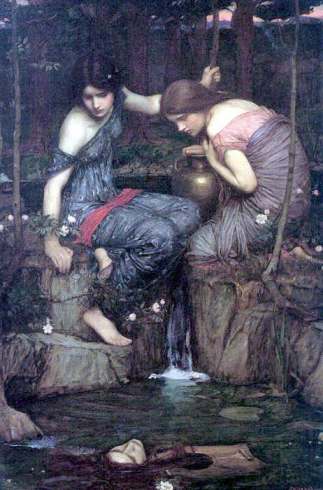
J. W. Waterhouse's Nymphs Finding the Head of Orpheus .
According to a Late Antique summary of Aeschylus's lost play Bassarids, Orpheus at the end of his life disdained the worship of all gods save the sun, whom he called Apollo. One early morning he ascended Mount Pangaion (where Dionysus had an oracle) to salute his god at dawn, but was torn to death by Thracian Maenads for not honoring his previous patron, Dionysus. It is significant that his death is analogous with the death of Dionysus, to whom therefore he functioned as a priest and avatar.
Ovid (Metamorphoses XI) also recounts that the Thracian Maenads, Dionysus' followers, spurned by Orpheus, first threw sticks and stones at him as he played, but his music was so beautiful even the rocks and branches refused to hit him. Enraged, the Maenads tore him to pieces during the frenzy of their Bacchic orgies. Medieval folkore put additional spin on the story: in Albrecht Dürer's drawing (illustration, left) the ribbon high in the tree is lettered Orfeus der erst puseran ("Orpheus, the first sodomite").
His head and lyre—still singing mournful songs—floated down the swift Hebrus to the Mediterranean shore. There, the winds and waves carried them on to the Lesbian shore, where the inhabitants buried his head and a shrine was built in his honour near Antissa. The lyre was carried to heaven by the Muses, and was placed amongst the stars. The Muses also gathered up the fragments of his body and buried them at Leibethra below Mount Olympus, where the nightingales sang over his grave. His soul returned to the underworld, where he was re-united at last with his beloved Eurydice.
In Attic vase painting, however, the women who attack Orpheus appear to be normal Thracian women, who are irritated that the bard's songs have stolen their husbands away from them.
Orphic poems and rites
A large number of Greek religious poems in hexameter were attributed to Orpheus, as they were to similar miracle-man figures like Bakis, Musaeus, Abaris, Aristeas, Epimenides, and the Sybil. Of this vast literature, only two examples survive whole: a set of hymns composed at some point in the 2nd or 3rd century AD, and an Orphic Argonautica composed somewhere between the 4th and 6th centuries AD. Earlier Orphic literature, which may date back as far as the 6th century BC, survives only in papyrus scraps or in quotations by later authors.
In addition to serving as a storehouse of mythological data along the lines of Hesiod's Theogony, Orphic poetry was recited in mystery-rites and purification rituals. Plato in particular tells of a class of vagrant beggar-priests who would go about offering purifications to the rich, a clatter of books by Orpheus and Musaeus in tow (Republic 364c-d). Those who were especially devoted to these ritual and poems often practiced vegetarianism, abstention from sex, and refrained from eating eggs — which came to be known as the Orphikos bios, or "Orphic way of life".
The post-classical Orpheus
In the Divine Comedy Dante sees the shade of Orpheus along with those of numerous other "virtuous pagans" in Limbo.
This story of Orpheus and Eurydice has been the subject of operas through the history of western classical music:
Claudio Monteverdi's Orfeo (1609)
Christoph Willibald Gluck's Orfeo ed Euridice (1762)
Johann Gottlieb Naumann's Orfeo ed Euridice (1785)
Friedrich August Kanne's Orpheus (1807)
Jeanne Granier and Vauthier in Offenbach's operetta "Orpheus in the Underworld" Atelier Nadar
Jacques Offenbach's operetta Orpheus in the Underworld (1858)
Darius Milhaud's Les malheurs d'Orphée (1924)
Harrison Birtwistle's The Mask of Orpheus (1986).
In a 1985 article in 19th Century Music musicologist Owen Jander controversially argued that the 2nd movement (Adanate con moto) of Beethoven's 4th Piano Concerto was programatically modelled after the Orpheus myth.
The Tennessee Williams play Orpheus Descending is a modern retelling of the Orpheus myth set in 1950's America. Sarah Ruhl's play Eurydice is an interpretive retelling of the myth of Orpheus from the point of view of his wife, Eurydice.

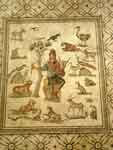
Film retellings and reinterpretations include:
Orphée, directed by Jean Cocteau (1949)
Black Orpheus (Orfeu Negro), directed by Marcel Camus (1959)
Orfeu, directed by Carlos Diegues (1999), essentially a remake of Black Orpheus.
The Czech-German poet Rainer Maria Rilke, sometimes called the last of the romantic authors, wrote the Sonnets to Orpheus immediately following the Duino Elegies.
The tale of Orpheus was mixed with Celtic fairy lore in the Middle English metrical romance Sir Orfeo. The myth of Orpheus was also retold in The Sandman comic books by Neil Gaiman, and in the Hugo Award-winning novella, Goat Song by Poul Anderson.
Russell Hoban's "The Medusa Frequency" alludes heavily to the Orpheus myth. In fact, the head of Orpheus is a central character, albeit inside another character's mind...
A modernised version of the myth of Orpheus is told in Nick Cave's song The Lyre Of Orpheus from the double album Abattoir Blues/The Lyre of Orpheus.
Orpheus appears as a member of Odysseus's last voyage from Ithaca in Nikos Kazantzakis' epic poem The Odyssey: A Modern Sequel.
Zarah Leander, "Ach, ich habe sie verloren .... Orpheus & Eurydice
Bibliography of reconstruction: Pindar,Pythian Odes, 4.176 (462 BC); Roman marble bas-relief, copy of a Greek original from the late 5th c. (c. 420 BC); Aristophanes, The Frogs 1032 (c. 400 BC); Phanocles, Erotes e Kaloi, 15 (3rd c. BC); Apollonios Rhodios, Argonautika, i.2 (c. 250 BC); Apollodorus, Library and Epitome 1.3.2 (140 BC); Diodorus Siculus, Histories I.23, I.96, III.65, IV.25 (1st c. BC); Conon, Narrations, 45 (50 - 1 BC); Virgil, Georgics, IV.456 (37 - 30 BC); Horace, Odes, I.12; Ars Poetica 391-407 (23 BC); Ovid, Metamorphoses X.1-85, XI.1-65 (AD 8); Seneca, Hercules Furens 569 (1st c. AD); Hyginus, Poetica Astronomica II.7 Lyre (2st c. AD); Pausanias, Description of Greece, 2.30.2, 9.30.4, 10.7.2 (AD 143 - 176); Anonymous, The Clementine Homilies, Homily V Chapter XV.-Unnatural Lusts (c. AD 400); Anonymous, Orphic Argonautica (5th c. AD); Stobaeus, Anthologium (c. AD 450); Second Vatican Mythographer, 44. Orpheus
Literature
Orpheus and Greek religion: a study of the Orphic movement, William Keith Chambers Guthrie
References
Ovid, Metamorphoses X, 1-105; XI, 1-66; Apollodorus, Bibliotheke I, iii, 2; ix, 16 & 25; Apollonius Rhodius, Argonautica I, 23- 34; IV, 891-909.
See also : Greek Mythology. Paintings, Drawings
| Ancient Greece
Science, Technology , Medicine , Warfare, , Biographies , Life , Cities/Places/Maps , Arts , Literature , Philosophy ,Olympics, Mythology , History , Images Medieval Greece / Byzantine Empire Science, Technology, Arts, , Warfare , Literature, Biographies, Icons, History Modern Greece Cities, Islands, Regions, Fauna/Flora ,Biographies , History , Warfare, Science/Technology, Literature, Music , Arts , Film/Actors , Sport , Fashion --- |
Retrieved from "http://en.wikipedia.org"
All text is available under the terms of the GNU Free Documentation License

